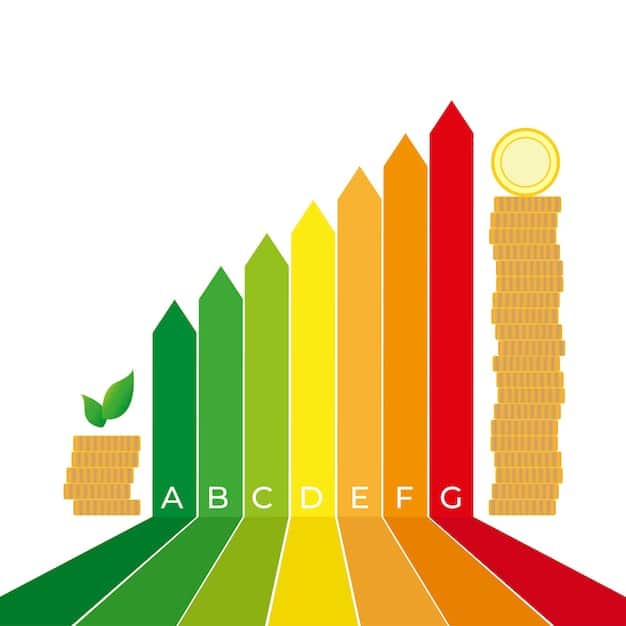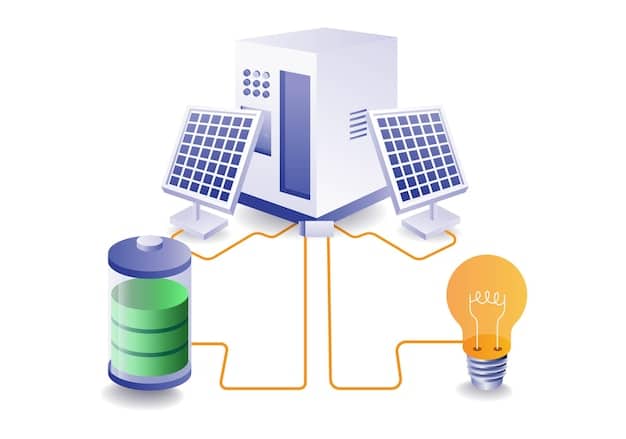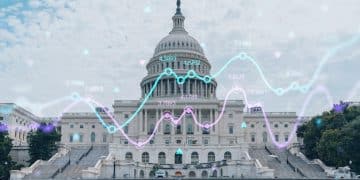Inflation Reduction Act: Renewable Energy Investment Impact in 2025

Anúncios
The Inflation Reduction Act (IRA) of 2022 contains key provisions like tax credits and grants that significantly boost renewable energy investments in the US, setting ambitious climate goals and reshaping the energy sector landscape by 2025.
The Inflation Reduction Act (IRA), enacted in 2022, represents a monumental shift in US energy policy. Understanding what are the key provisions of the Inflation Reduction Act that will impact US renewable energy investments in 2025 is vital for investors, businesses, and policymakers alike.
Anúncios
Understanding the Inflation Reduction Act’s Core Objectives
The Inflation Reduction Act addresses several critical areas, with a significant focus on climate change and clean energy. Its primary objectives related to renewable energy include incentivizing investments in clean energy technologies, reducing greenhouse gas emissions, and fostering energy independence.
These objectives are pursued through a combination of tax incentives, grants, and loan programs, all designed to make renewable energy more competitive and accessible.
Anúncios
Key Areas of Focus
The IRA targets several specific areas within the renewable energy sector:
- Production Tax Credits (PTC): Incentives for electricity generated from renewable sources.
- Investment Tax Credits (ITC): Credits for investments in renewable energy facilities.
- Direct Pay Provisions: Allowing certain entities to receive direct payments in lieu of tax credits.
- Grants and Loan Programs: Supporting the development and deployment of clean energy technologies.
The Act aims to lower energy costs for consumers, create jobs in the clean energy sector, and position the US as a global leader in renewable energy innovation and deployment.
By strategically addressing these areas, the Inflation Reduction Act seeks to create a more sustainable and resilient energy economy.

Tax Credits: A Major Driver for Renewable Energy Investment
Among the most impactful components of the IRA are the expanded and extended tax credits for renewable energy. These credits are designed to reduce the upfront costs of renewable energy projects and improve their economic viability.
The Act modifies and extends both the Production Tax Credit (PTC) and the Investment Tax Credit (ITC), providing long-term certainty for investors and developers.
Production Tax Credit (PTC) Enhancements
The PTC, which provides a per-kilowatt-hour credit for electricity generated from renewable sources, has been extended through 2032. The credit is available for wind, solar, biomass, and other eligible renewable energy facilities.
The IRA introduces a “bonus” credit for projects that meet certain labor standards, such as paying prevailing wages and using qualified apprentices. This incentivizes developers to create high-quality jobs in the renewable energy sector.
Investment Tax Credit (ITC) Enhancements
The ITC, which provides a credit based on the cost of investments in renewable energy facilities, has also been extended through 2032. The credit is available for solar, wind, energy storage, and other eligible technologies.
Similar to the PTC, the IRA introduces a bonus credit for projects that meet certain domestic content requirements. This encourages the use of domestically manufactured components in renewable energy projects, supporting US manufacturing and supply chains.
Together, these ITC and PTC enhancements significantly improve the financial attractiveness of renewable energy investments, making it easier for projects to secure financing and move forward.
The tax credits serve as a powerful incentive for private sector investment in renewable energy, driving innovation and deployment across the country.
Direct Pay Provisions: Expanding Access to Tax Credits
One of the most innovative aspects of the IRA is the introduction of direct pay provisions, which allow certain entities to receive direct payments from the government in lieu of tax credits. This is particularly beneficial for tax-exempt organizations, state and local governments, and rural electric cooperatives.
Historically, these entities have faced challenges in utilizing tax credits due to their limited tax liability. The direct pay provisions address this barrier, making it easier for them to invest in renewable energy projects.
Here are the highlights of the direct pay provisions:
- Tax-Exempt Entities: Non-profit organizations, public universities, and other tax-exempt entities can elect to receive direct payments for certain renewable energy tax credits.
- State and Local Governments: State, county, and municipal governments can also access direct pay for renewable energy projects.
- Rural Electric Cooperatives: These cooperatives, which serve many rural communities, can benefit from direct pay for investments in renewable energy and energy efficiency.
Direct pay provisions not only expand access to federal incentives but also promote equity in the renewable energy sector, ensuring that a wider range of organizations and communities can participate in the clean energy transition.
This mechanism levels the playing field and encourages more diverse participation in renewable energy development.
Grants and Loan Programs: Catalyzing Innovation and Deployment
In addition to tax credits, the IRA includes significant investments in grant and loan programs designed to accelerate the development and deployment of clean energy technologies. These programs provide critical funding for research, development, and deployment of innovative renewable energy projects.
The IRA authorizes billions of dollars in new funding for programs at the Department of Energy (DOE) and other federal agencies. These programs support a wide range of activities, including:
- Advanced Energy Manufacturing: Supporting the manufacturing of clean energy technologies in the US.
- Clean Energy Loan Programs: Providing loans and loan guarantees for renewable energy projects.
- Grid Modernization: Investing in the modernization of the electric grid to accommodate more renewable energy.
Through these grant and loan programs, the IRA aims to de-risk innovative technologies, lower the costs of renewable energy, and accelerate the transition to a clean energy economy.
These targeted investments foster innovation and help scale up promising renewable energy technologies.
The Impact on Specific Renewable Energy Sectors
The IRA’s provisions are expected to have a significant impact on various renewable energy sectors, including solar, wind, energy storage, and biofuels. Each sector stands to benefit from the Act’s incentives and investments in unique ways.
Let’s assess what the overall impact is:
Solar Energy
The solar energy sector is poised for substantial growth under the IRA. The extended and enhanced ITC will drive investments in both utility-scale and distributed solar projects. The bonus credit for domestic content will further incentivize the use of US-made solar panels and components.
Wind Energy
The wind energy sector will also benefit from the extended and enhanced PTC. The bonus credit for projects that meet labor standards will encourage the creation of high-paying jobs in the wind industry. Investments in offshore wind projects are also expected to increase.

Energy Storage
The IRA includes a standalone ITC for energy storage projects, which will accelerate the deployment of battery storage and other energy storage technologies. Energy storage is critical for integrating variable renewable energy sources like solar and wind into the grid.
Biofuels
The IRA extends and modifies tax credits for biofuels, supporting the production and use of sustainable biofuels in transportation and other sectors. These credits help to reduce greenhouse gas emissions from the transportation sector and promote rural economic development.
Overall, the IRA’s comprehensive approach will drive growth and innovation across the entire renewable energy sector.
Forecasting Renewable Energy Investments in 2025
Looking ahead to 2025, the IRA is expected to have a profound impact on renewable energy investments in the US. The Act’s tax credits, direct pay provisions, and grant and loan programs will create a more favorable investment climate for renewable energy projects.
Industry analysts project a significant increase in renewable energy installations and investments over the next few years. Solar and wind capacity is expected to grow substantially, driving down the cost of renewable energy and accelerating the transition to a clean energy economy.
Predictions include:
- Increased Investment: Renewable energy investments are projected to increase by billions of dollars annually.
- Job Creation: The clean energy sector is expected to create hundreds of thousands of new jobs.
- Reduced Emissions: Greenhouse gas emissions are projected to decline significantly.
The IRA is not only driving investment in renewable energy but also creating new economic opportunities and improving the health and well-being of communities across the country.
The impact of these provisions is expected to unfold gradually, reaching full potential by 2025.
| Key Area | Brief Description |
|---|---|
| 💰Tax Credits | Extended credits for renewable energy production and investment. |
| 💸 Direct Pay | Allows certain entities to receive direct payments instead of credits. |
| 🌱 Grants & Loans | Funds for research, development, and deployment of green tech. |
| 🏭 Manufacturing | Incentives boost domestic clean energy manufacturing. |
Frequently Asked Questions
▼
The Inflation Reduction Act primarily aims to incentivize investments in clean energy technologies and reduce greenhouse gas emissions in the U.S.
▼
Tax credits significantly reduce the upfront costs of renewable energy projects, making them more economically viable and attractive to investors.
▼
Tax-exempt organizations, state and local governments, and rural electric cooperatives can benefit from direct pay provisions by receiving direct payments.
▼
Grant and loan programs catalyze innovation and deployment by providing critical funding for research, development, and deployment of innovative renewable energy.
▼
The solar energy sector is forecasted for substantial growth, driven by the extended ITC, increasing investments in utility-scale and distributed solar projects.
Conclusion
The Inflation Reduction Act is set to reshape the landscape of US renewable energy investments by 2025, fostering growth, innovation, and sustainability through its key provisions and incentives.





